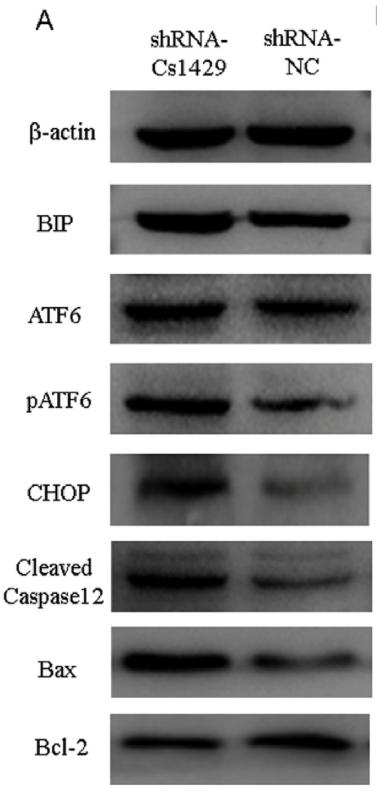产品描述
*The optimal dilutions should be determined by the end user.
*Tips:
WB: 适用于变性蛋白样本的免疫印迹检测. IHC: 适用于组织样本的石蜡(IHC-p)或冰冻(IHC-f)切片样本的免疫组化/荧光检测. IF/ICC: 适用于细胞样本的荧光检测. ELISA(peptide): 适用于抗原肽的ELISA检测.
引用格式: Affinity Biosciences Cat# AF4507, RRID:AB_2844556.
展开/折叠
Activating transcription factor 6 alpha; Activating transcription factor 6; ATF 6; ATF6 alpha; ATF6; ATF6-alpha; ATF6A; ATF6A_HUMAN; cAMP dependent transcription factor ATF 6 alpha; cAMP-dependent transcription factor ATF-6 alpha; Cyclic AMP dependent transcription factor ATF 6 alpha; DKFZp686P2194; ESTM49; FLJ21663; Processed cyclic AMP dependent transcription factor ATF 6 alpha; Processed cyclic AMP-dependent transcription factor ATF-6 alpha;
抗原和靶标
A synthesized peptide derived from human ATF6 around the phosphorylation site of Thr166.
- P18850 ATF6A_HUMAN:
- Protein BLAST With
- NCBI/
- ExPASy/
- Uniprot
MGEPAGVAGTMESPFSPGLFHRLDEDWDSALFAELGYFTDTDELQLEAANETYENNFDNLDFDLDLMPWESDIWDINNQICTVKDIKAEPQPLSPASSSYSVSSPRSVDSYSSTQHVPEELDLSSSSQMSPLSLYGENSNSLSSAEPLKEDKPVTGPRNKTENGLTPKKKIQVNSKPSIQPKPLLLPAAPKTQTNSSVPAKTIIIQTVPTLMPLAKQQPIISLQPAPTKGQTVLLSQPTVVQLQAPGVLPSAQPVLAVAGGVTQLPNHVVNVVPAPSANSPVNGKLSVTKPVLQSTMRNVGSDIAVLRRQQRMIKNRESACQSRKKKKEYMLGLEARLKAALSENEQLKKENGTLKRQLDEVVSENQRLKVPSPKRRVVCVMIVLAFIILNYGPMSMLEQDSRRMNPSVSPANQRRHLLGFSAKEAQDTSDGIIQKNSYRYDHSVSNDKALMVLTEEPLLYIPPPPCQPLINTTESLRLNHELRGWVHRHEVERTKSRRMTNNQQKTRILQGALEQGSNSQLMAVQYTETTSSISRNSGSELQVYYASPRSYQDFFEAIRRRGDTFYVVSFRRDHLLLPATTHNKTTRPKMSIVLPAININENVINGQDYEVMMQIDCQVMDTRILHIKSSSVPPYLRDQQRNQTNTFFGSPPAATEATHVVSTIPESLQ
种属预测
score>80的预测可信度较高,可尝试用于WB检测。*预测模型主要基于免疫原序列比对,结果仅作参考,不作为质保凭据。
High(score>80) Medium(80>score>50) Low(score<50) No confidence
研究背景
Transmembrane glycoprotein of the endoplasmic reticulum that functions as a transcription activator and initiates the unfolded protein response (UPR) during endoplasmic reticulum stress. Cleaved upon ER stress, the N-terminal processed cyclic AMP-dependent transcription factor ATF-6 alpha translocates to the nucleus where it activates transcription of genes involved in the UPR. Binds DNA on the 5'-CCAC[GA]-3'half of the ER stress response element (ERSE) (5'-CCAAT-N(9)-CCAC[GA]-3') and of ERSE II (5'-ATTGG-N-CCACG-3'). Binding to ERSE requires binding of NF-Y to ERSE. Could also be involved in activation of transcription by the serum response factor. May play a role in foveal development and cone function in the retina.
During unfolded protein response, a fragment of approximately 50 kDa containing the cytoplasmic transcription factor domain is released by proteolysis. The cleavage seems to be performed sequentially by site-1 and site-2 proteases.
N-glycosylated. The glycosylation status may serve as a sensor for ER homeostasis, resulting in ATF6 activation to trigger the unfolded protein response (UPR).
Phosphorylated in vitro by MAPK14/P38MAPK.
Endoplasmic reticulum membrane>Single-pass type II membrane protein.
Nucleus.
Note: Under ER stress the cleaved N-terminal cytoplasmic domain translocates into the nucleus. THBS4 promotes its nuclear shuttling.
Ubiquitous.
The basic domain functions as a nuclear localization signal.
The basic leucine-zipper domain is sufficient for association with the NF-Y trimer and binding to ERSE.
Belongs to the bZIP family. ATF subfamily.
研究领域
· Genetic Information Processing > Folding, sorting and degradation > Protein processing in endoplasmic reticulum. (View pathway)
· Human Diseases > Neurodegenerative diseases > Alzheimer's disease.
文献引用
Application: WB Species: mouse Sample: shRNA-Cs1429 cells
限制条款
产品的规格、报价、验证数据请以官网为准,官网链接:www.affbiotech.com | www.affbiotech.cn(简体中文)| www.affbiotech.jp(日本語)产品的数据信息为Affinity所有,未经授权不得收集Affinity官网数据或资料用于商业用途,对抄袭产品数据的行为我们将保留诉诸法律的权利。
产品相关数据会因产品批次、产品检测情况随时调整,如您已订购该产品,请以订购时随货说明书为准,否则请以官网内容为准,官网内容有改动时恕不另行通知。
Affinity保证所销售产品均经过严格质量检测。如您购买的商品在规定时间内出现问题需要售后时,请您在Affinity官方渠道提交售后申请。产品仅供科学研究使用。不用于诊断和治疗。
产品未经授权不得转售。
Affinity Biosciences将不会对在使用我们的产品时可能发生的专利侵权或其他侵权行为负责。Affinity Biosciences, Affinity Biosciences标志和所有其他商标所有权归Affinity Biosciences LTD.









